2. 北京大学地球与空间科学学院, 北京 100871;
3. 南方海洋科学与工程广东省实验室(广州), 广州 511458
2. School of Earth and Space Sciences, Peking University, Beijing 100871, China;
3. Southern Marine Science and Engineering Guangdong Laboratory (Guangzhou), Guangzhou 511458, China
断层以及断层附近的破裂带作为流体运移的通道,在地震活动期间能够沟通不同层次流体,如大气水、地壳流体、幔源流体(Menzies et al., 2014;Barberio et al., 2017)。地震过程中富含CO2流体运移时,由于岩石破裂导致的流体压力降低,以及不同来源流体混合时导致的矿物溶解度变化,在断层的阶步以及破碎带裂缝中会产生矿物沉淀,形成方解石脉(Dolejš and Manning,2010;De Filippis et al., 2013;Brogi et al., 2014)。方解石脉的显微结构可以指示其与地震事件的关系:同构造期沉淀脉体结构为块状、拉长块状和扩展状,其中同震阶段形成的脉体由于裂隙开启过程中流体压力快速下降导致的高矿物饱和度,一般具有块状等粒结构(Verhaert et al., 2003;Boullier et al., 2004;Uysal et al., 2007;Watanabe et al., 2008;Nuriel et al., 2012);震间期压溶-沉淀,常见结构为“压力影”和超压泥页岩层中发育的纤维脉(Eyal et al., 1992;Bons et al., 2012; Zhang et al., 2015);震间期开放裂缝沉淀,常见类型为浅表暴露面的泥质薄层(Flotté et al., 2001;Verhaert et al., 2004;Nuriel et al., 2011)。沿断层发育的方解石脉作为地震期间断层活动和裂缝开放的记录(Boullier et al., 2004;Williams et al., 2017),其地球化学示踪剂如同位素,REY(稀土元素和钇)模式,可以用于推断发震时期以及地壳流体循环路径(Nollet et al., 2005;Uysal et al., 2011;Bergman et al., 2013)。由于非地震活动成因的脉体流体来源为相邻围岩,因此脉体地球化学和同位素多具有与围岩相似的特征。地震活动相关脉体具有更大的外部流体来源贡献,地球化学特征与围岩常具有明显差异。因此,对断层方解石脉的研究有助于更好地理解地震行为、地震周期以及地壳内部流体循环模式。
青藏高原的东西向伸展产生了一系列南北向裂谷(图 1),是藏南地区最显著的活动构造(Molnar and Tapponnier, 1978;Tapponnier et al., 1981;Armijo et al., 1986;Kapp and Guynn, 2004)。亚东-古露裂谷是南北向裂谷系中规模最大的裂谷,地震活动性最强、发震频率最高(Wu et al., 2011)。自公元1264年以来,亚东-古露裂谷内部及周缘共发生了17次Mw>6.0的地震,其中14次发生在裂谷北段和中段,即雅鲁藏布江至古露之间(Chevalier et al., 2020)。裂谷南段第四纪地震活动研究同样缺乏,仅在帕里地堑有两处报道,分别为地震崩滑体以及地表破裂带(Peng et al., 2018;Ha et al., 2019a)。作为藏南地区规模最大的裂谷系,亚东-谷露裂谷南段延伸约200km,在裂谷东侧的基岩内有广泛的断层出露(图 2)。裂谷断层附近发育的方解石脉能够为同震断裂活动研究提供依托。
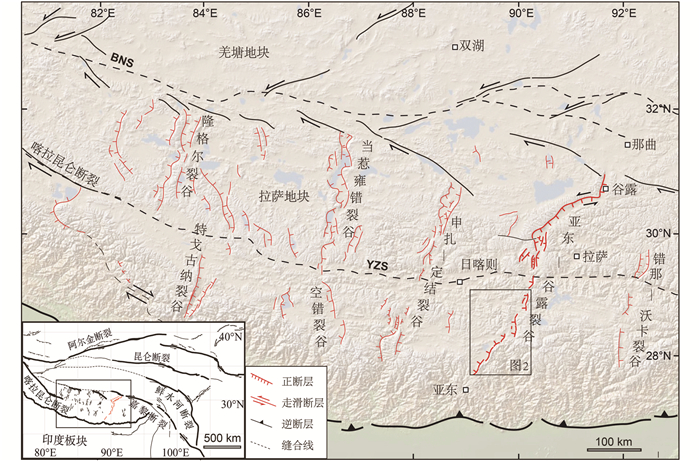
|
图 1 藏南地区正断层分布和亚东-谷露裂谷位置 BNS-班公-怒江缝合带;YZS-雅鲁藏布缝合带;图中黑色方框为研究区;断层分布来自Tapponnier et al. (2001); Kapp et al. (2008); Baltz (2012) Fig. 1 Normal faults distribution and location of Yadong-Gulu rift in southern Tibet (modified after Tapponnier et al., 2001; Kapp et al., 2008; Baltz, 2012) BNS-Bangong-Nujiang suture; YZS-Yarlung Zangbo suture |
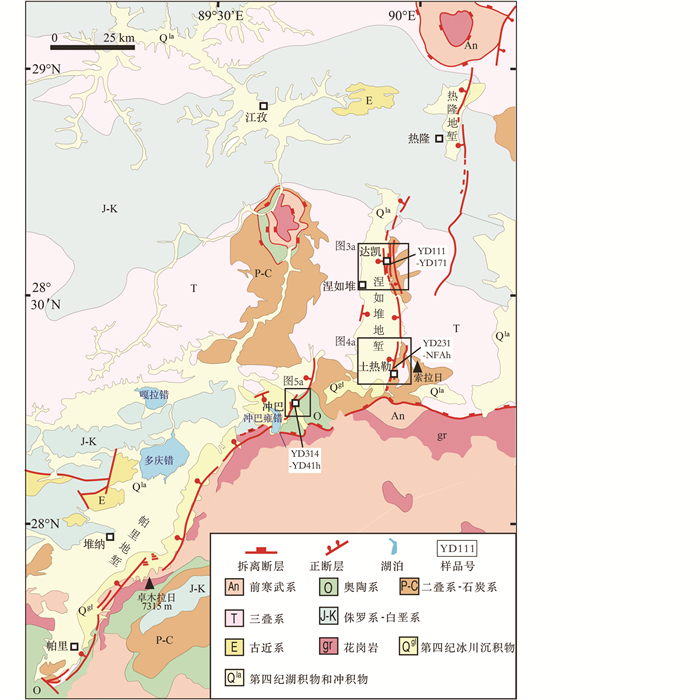
|
图 2 亚东裂谷区域地质简图(据Zhang et al., 2012; 刘文灿等,2014) Fig. 2 Geological sketch of Yadong rift area (modified after Zhang et al., 2012 and Liu et al., 2014) |
本文对亚东裂谷断层涅如堆段和帕里段发育的方解石脉体进行了显微结构,C-O-Sr同位素,REY元素以及U-Th定年研究,确定了矿物沉淀与地震事件的关系,发生时间以及流体来源。结合野外调查,讨论了中更新世以来亚东裂谷的伸展速率变化。
1 地质背景亚东-谷露裂谷作为藏南地区规模最大的一条裂谷,自南向北依次穿过高喜马拉雅、特提斯喜马拉雅、雅鲁藏布江缝合带、拉萨地块,终止于拉萨地块北缘,全长约500km,总体表现为半地堑和地堑(图 1)(Armijo et al., 1986;Wu et al., 1998;Leloup et al., 2010)。亚东-谷露裂谷南段即亚东裂谷,位于雅鲁藏布江缝合带与印度板块之间,长约200km,由三个北北东走向的地堑(帕里地堑、涅如堆地堑和热隆地堑)右阶组成(图 2)。每个地堑长约45~80km,宽约20km,边界断层为裂谷东侧北西向延伸的西倾正断层(Ha et al., 2019b; Wang et al., 2020)。亚东裂谷断层行迹清晰,可以观察到新鲜的地表破裂带,以及山根处的断层三角面,代表裂谷发生了较为活跃的伸展变形,晚第四纪以来亚东裂谷的平均伸展速率为0.9±0.3mm/yr(Ha et al., 2019b;Wang et al., 2020)。
亚东裂谷发育在前寒武系变质岩、下古生界、上古生界、中生界和新生界中(图 2)。前寒武系为高喜马拉雅结晶岩带亚东岩群。下古生界主要为奥陶系灰岩、粉砂岩。上古生界为陆相沉积,其中石炭系多为碳酸盐台地相沉积,以灰岩为主,二叠系主要为砂岩、砾岩及灰岩(刘文灿等,2014)。中生界在裂谷带分布广泛,下、中三叠统主要为砂质板岩、炭质板岩,上三叠统为变质细砂岩和粉砂质板岩。侏罗系、白垩系以海相沉积为主,主要岩性为砂岩、页岩和硅质岩等。新生代地层主要为碳酸盐和浅海陆源碎屑沉积(万晓樵等,2002)。新近系沉积受地貌、湖泊、断裂影响明显,多见河湖相、洪积和坡积相、冰碛相沉积,均不整合于下覆地层之上(刘文灿等,2006;Liu et al., 2017)。研究区内岩浆岩主要沿断裂出露,基性侵入岩出露较少,中酸性侵入岩分布面积较大,主要由加里东期花岗岩和新生代淡色花岗岩组成(张宏飞等,2005;刘文灿等,2014)。
2 方解石样品采集与测试方法本文通过卫星照片和野外调查确定断层展布、产状和方解石脉体的发育位置,并采集定向样品。在对方解石脉样品切割、抛光,超声波清洗以去除风化表面后,使用1~2mm微钻获取样品粉末。对于方解石脉,为了避免围岩污染,至少远离围岩或角砾1mm采集样本。对于围岩,同样在远离裂隙和脉体1mm处采集样品。最终将所得的脉和围岩样本用于稀土元素和C-O-Sr同位素分析以及U系列测年。所有抛光样品均制备了显微薄片,以进行光学和阴极发光(CL)显微镜的微观结构分析。
碳氧同位素分析在中国地质科学院矿产资源研究所自然资源部成矿作用与资源评价重点实验室完成。采用GasBench Ⅱ连续流法,称量约100μg碳酸盐样品加入无水磷酸后置于72℃加热盘中反应并平衡,反应生成的CO2气体进入MAT253质谱仪进行测定。标准样品为GBW04416、GBW04417、GBW04405和GBW04406,测试结果的δ18O以相对国际标准V-PDB和V-SMOW表示,δ13C以相对国际标准V-PDB表示,测试精度均高于0.1‰。δ18OV-SMOW采用公式δ18OV-SMOW=1.0309×δ18OV-PDB+30.91计算(Coplen et al., 1983)。
Sr同位素分析在中国科学院地质与地球物理研究所固体同位素地球化学实验室完成。化学前处理及同位素测试流程参考Li et al.(2019),测试仪器为Thermofisher-Triton-Plus多接收热电离质谱仪。采用国际标准样品NBS987对数据采集期间的仪器稳定性进行了评价,测量平均值为87Sr/86Sr=0.710249±0.000012,与报告值一致(Li et al., 2019)。
稀土元素含量分析在中国科学院地质与地球物理研究所成矿年代学实验室进行。称取40mg样品粉末加入2%HNO3溶解,待溶解完成后加入1mL 500×10-9 In内标,并用1%HNO3稀释至50g。测试仪器为ICP-MS(Element)。采用标准曲线法以In内标校准仪器漂移。以国家标准参考物质(花岗岩GSR1;安山岩GSR2;玄武岩GSR3)进行质量监控,绝大多数元素RSD≤10%。
铀系测年在西安交通大学同位素实验室使用MC-ICP-MS(Thermo-Finnigan Neptune-plus)进行。化学前处理方法参照Edwards et al.(1987)。仪器、标准化、半衰期和测试流程见Cheng et al.(2000, 2013)。
3 断层与脉体特征 3.1 宏观特征方解石脉和围岩样品获取自亚东裂谷的三个采样点,分别为涅如堆地堑北侧达凯研究点和南侧土热勒研究点,以及帕里地堑北部的冲巴研究点(图 2)。
达凯剖面位于涅如堆地堑北部东侧达凯村东南2km处,剖面长约350m,围岩为上二叠统板岩,自东向西分别发育断层破碎带以及F1和F2两条断层(图 3a-c)。断层F1倾向292°、倾角69°,F2倾向308°、倾角51°,与区域内亚东裂谷断层产状一致,破碎带内发育一组与断层走向一致倾向相反的共轭破裂(图 3c-f)。沿次级破裂和断层面的阶步位置充填方解石脉(图 3d-k),脉体颜色为浅灰色和黄色,厚度0.3~1cm长度小于10cm(图 3d-g)。

|
图 3 涅如堆地堑正断层构造特征(达凯研究点) (a)达凯研究点地质简图;(b)达凯研究点卫星图片和断层分布,红线为断层,白线为剖面位置;(c)地质剖面;(d-g)沿断层和次级破裂面发育的方解石脉,手标本照片及采样点位置见图 6a-d;等面积、下半球赤平投影代表断面产状以及擦痕方位 Fig. 3 Field characteristics of the Dakai normal fault in the Nierudui graben (a) geological sketch of the Dakai site; (b) satellite image and fault distribution of the Dakai site. Faults in red, profile location as white line; (c) profile of the Dakai site; (d-g) calcite veins from within faults and secondary fractures. Details of the sampling sites are shown in Fig. 6a-d. Schmidt net (lower hemisphere) for attitude and slip vector of the faults |
土热勒剖面位于涅如堆地堑南部东侧,长约300m,围岩为上二叠统灰岩,自东向西分别发育F3和F4两条断层,断层F3倾向289°、倾角57°,F4倾向291°、倾角64°,卫星影像上两条断层迹线清晰(图 4a-c)。靠近盆地的F3断层错断上下盘灰岩,形成典型的断层三角面,断层面底部距离顶部约150m,底部1.5m为白色新鲜面,为最近一次古地震的地震遗迹(图 4d-e)。F3和F4断层之间为碎裂岩带,表现为方解石胶结的灰岩角砾或早期方解石角砾,断层两侧发育破碎带(图 4f)。该点方解石脉或方解石胶结物颜色为白色和黄色(图 4e, f)。
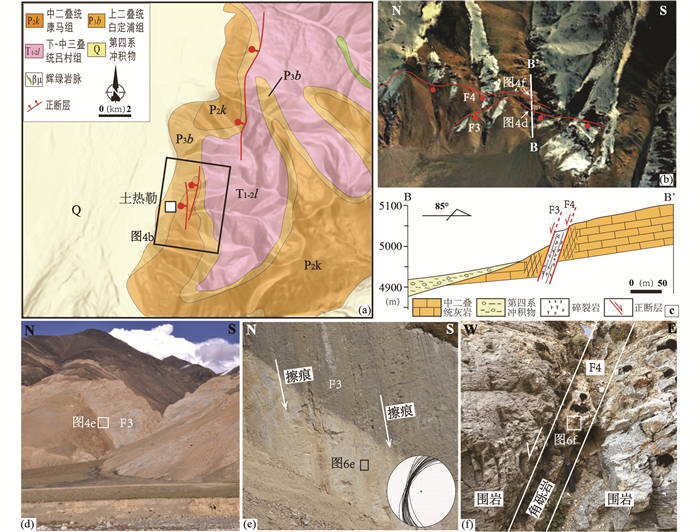
|
图 4 涅如堆地堑正断层构造特征(土热勒研究点) (a)土热勒研究点地质简图;(b)研究点卫星图片和断层分布,红线为断层,白色线为剖面位置;(c)涅如堆地堑构造剖面特征;(d、e) F3断层三角面特征,等面积、下半球赤平投影展示的代表断面产状;(f) F4断层特征,手标本照片及采样点位置见图 6e-f Fig. 4 Structural characteristics of the Turele normal fault in the Nierudui graben (a) geological sketch of the Turele site; (b) satellite image and fault distribution: Faults in red, profile location as white line; (c) profile of the Turele site; (d, e) photos of F3 scarp and Schmidt net (lower hemisphere) for attitude of the fault, the white arrows are the striations; (f) panoramic view of fault F4. Details of the sampling sites are shown in Fig. 6e, f |
冲巴剖面位于帕里地堑冲巴芒错北部约2km处,岩性为奥陶系灰岩以及上覆第四系冰川沉积物(图 5a)。该点发育F5、F6、F7三条断层(图 5b, c),其中F5为裂谷边界主断层,倾向320°、倾角60°,上盘发育第四系冲积物和钙华,下盘为奥陶系灰岩,沿断层发育约1m宽的灰黑色断层泥及下盘破碎带。F6、F7为次级断层,断层F6倾向240°、倾角66°,F7倾向300°、倾角54°,断层切穿上下盘奥陶系泥晶灰岩,两侧均为断层破碎带,发育断层角砾岩(图 5b-g),沿F6断层面可见沿擦痕充填的白色方解石脉(图 5g),沿F7断层面发育厚层方解石脉,宽度可达5cm,颜色为白色和灰白色(图 5g、图 6g-j)。
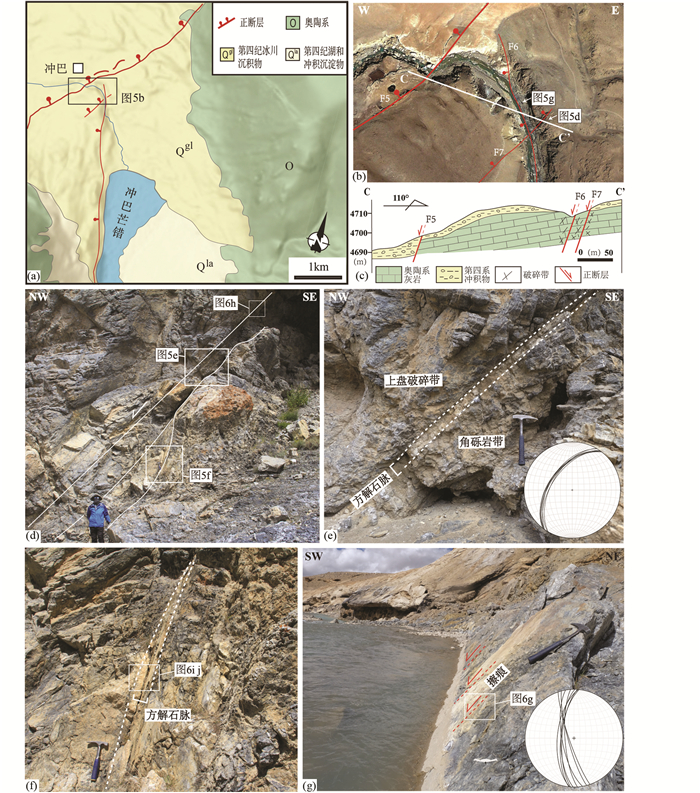
|
图 5 帕里地堑正断层构造特征(冲巴研究点) (a)冲巴研究点地质简图;(b) 冲巴研究点卫星图片和断层分布,红线为断层,白色线为剖面位置;(c)冲巴断层构造剖面;(d-f) F7断层结构特征,下半球赤平投影代表断面产状;(g) F6断层特征,下半球赤平投影代表断面产状.手标本照片及采样点位置见图 6g-j Fig. 5 Structural characteristics of the Chumba normal fault in the Pagri graben (a) geological sketch of the Chumba site; (b) satellite image and fault distribution. Faults in red, profile location as white line; (c) profile across the Chumba normal faults; (d-f) structure of fault F7; (g) striations on F6 fault plane with Stereonet plot (lower hemisphere) showing the attitude of the fault. Details of the sampling sites are shown in Fig. 6g-j |
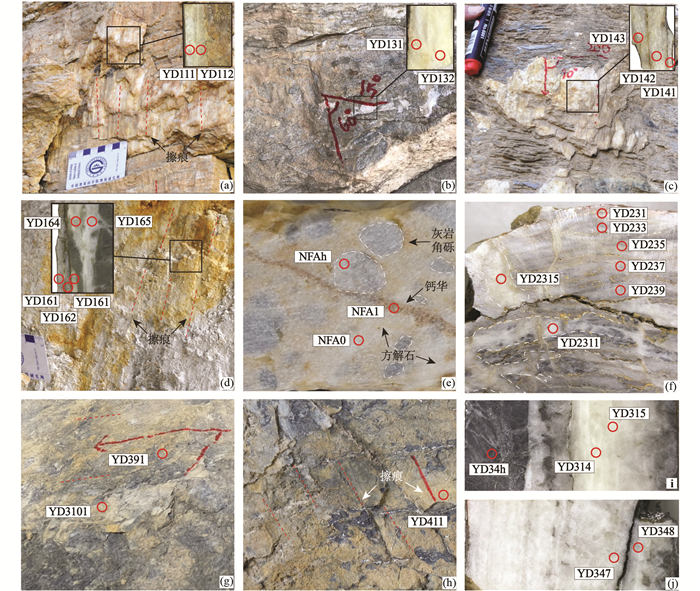
|
图 6 断层活动相关的方解石脉体野外宏观构造特征及采样位置 (a-d)达凯研究点方解石脉体特征,断层阶步发育丰富的方解石,脉体表面及附近断层面可见明显擦痕,沿脉体截面可见多层方解石平行发育,照片位置见图 3d-g;(e、f)土热勒研究点方解石样品照片,方解石平行于断层面发育,表现为灰岩围岩胶结物,照片位置见图 4e-f;(g-j)冲巴研究点方解石样品照片,其中g-h为沿断层面阶步处大量发育方解石,方解石晶面发育擦痕;(i-j)沿冲巴F7断层面发育厚层(5cm)方解石脉,图片位置见图 4d, f, g. 图中红色圆圈为地球化学和年代学样品取样位置,编码为样品号 Fig. 6 Field macrostructure characteristics and sampling locations of calcite veins related to fault activity (a-d) Dakai site where abundant calcite veins are present in fault scarps. Clear scratches can be seen on the surface of the vein and fault plane, as well as multiple layers of calcite along the cross section of the vein. See Figure 3d-g for photo locations. (e, f) photos of calcite samples at Turele site. Calcite is parallel to fault plane and is the cement around the limestone breccia. Photo location in Fig. 4e, f. (g-j) photos of calcite samples at Chumba site, in which g-h is calcite along the fault scarp, with clear striations on the vein surfaces. (i-j) thick calcite vein (5cm) along the Chumba F7 fault plane. Multi-stage layered structure separated by host rock bands are shown. Positions are shown in Fig. 4d, f, g. Red circle indicates sampling location of geochemical and chronological samples, and code represents sample number |
涅如堆地堑北侧达凯研究点(图 7a, c-e)和帕里地堑北部的冲巴研究点(图 7f)阶步处充填的方解石脉均为块状结构,部分脉体中可见岩石破碎形成的不规则的围岩角砾(图 7a)。方解石脉体边界不平直,呈弯曲状(图 7c)或锯齿状(图 7e)。达凯研究点处方解石脉表现为多期次特征,同一裂隙中充填了粒径不同的多条平行脉体(图 7c, e)。粗颗粒方解石粒径可达1mm,发育双晶,细颗粒方解石粒径0.1~0.4mm。方解石阴极发光颜色均匀,晶体没有观察到分带,表明在方解石脉生长过程中没有显著化学成分变化,粗粒的块状脉阴极发光颜色为暗红色,细粒块状方解石阴极发光颜色为红色(图 7e)。单层脉体内部可见平直的后期破裂,延伸方向与边界主破裂方向相同(图 7d)。
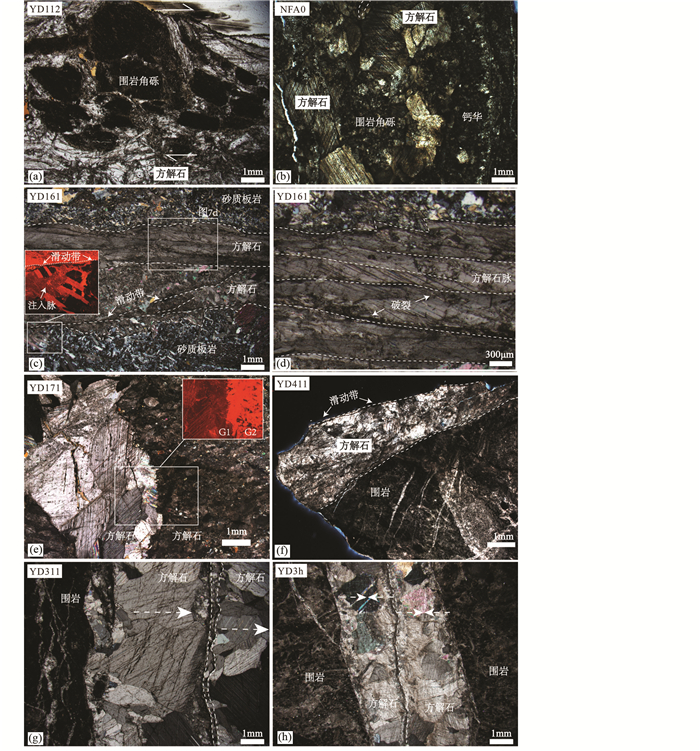
|
图 7 亚东裂谷与正断活动相关的方解石脉微观构造特征 达凯断层(a)和土热勒断层(b)角砾间充填的方解石脉;(c, d)达凯断层处两期方解石脉,粒径大小不同,上层方解石脉中发育多条与岩壁平行的平直破裂面;(e)达凯断层处两期方解石脉,G1脉体晶体粒径粗大,发育双晶,脉体具有破碎的不平直边界,G2脉体晶粒较小,且具有更明亮的阴极发光颜色,表明方解石脉代表两次破裂-愈合事件;(f)沿冲巴F6断层发育的方解石脉,具有块状结构;(g、h)冲巴F7断层处发育的方解石脉,方解石晶体从围岩向远离围岩方向生长,靠近围岩的区域显示明显的竞争生长特征 Fig. 7 Microstructure characteristics of calcite veins related to normal fault activity in Yadong rift, Tibet Calcite veins filled between breccias of Dakai fault (a) and Turele fault (b); (c, d) the two phases of calcite veins have different particle sizes, with many linear fracture planes parallel to the host wall in the upper calcite vein; (e) two phases of calcite veins, crystal type, particle size and cathodoluminescence color indicate that each phase of calcite vein represents a crack-sealing event; (f) Calcite vein along the fault scratch, with blocky structure; (g, h) calcite crystal growing away from host rock, and area close to host wall shows clear competitive growth characteristics |
土热勒断层面上的方解石脉同样具有块状晶体特征,发育双晶。方解胶结物中含有围岩或先期方解石角砾,角砾呈棱角状,磨圆差(图 7b)。
冲巴研究点沿F6断层阶步位置发育的方解石脉具有块状结构,靠近擦痕的暴露面以及脉体-围岩边界呈弯曲状(图 7f)。沿F7断层发育一处厚层(5cm)方解石脉,脉体-围岩边界呈弯曲或锯齿状,方解石晶体表现为晶体拉长、长轴方向垂直于围岩岩壁(图 7g)。晶体从脉-围岩界面向脉中心方向生长,同向生长导致脉-围岩界面处存在生长竞争。脉体中间夹杂的围岩条带以及再次出现的方解石晶体竞争生长表明脉体经历了再次开启-愈合过程(图 7g)。靠近F7断层的上盘围岩内发育的方解石细脉同样具有多次沉淀的特征,脉体-围岩边界较平直,晶体竞争生长方向表明第二次破裂发生在先期脉-围岩界面处(图 7h)。
4 地球化学特征为确定形成方解石脉的流体来源,本文在达凯、土热勒和冲巴研究点采集了碳氧同位素样品33个,锶同位素样品29个以及稀土元素-钇样品28个。
4.1 碳氧同位素δ13CV-PDB和δ18OV-SMOW分析结果示于表 1和图 8a。
|
|
表 1 亚东裂谷方解石脉、围岩和钙华的氧-碳-锶同位素值 Table 1 Summary of the oxygen, carbon, and strontium isotopic compositions of veins, travertine, and host rocks in the Yadong rift |
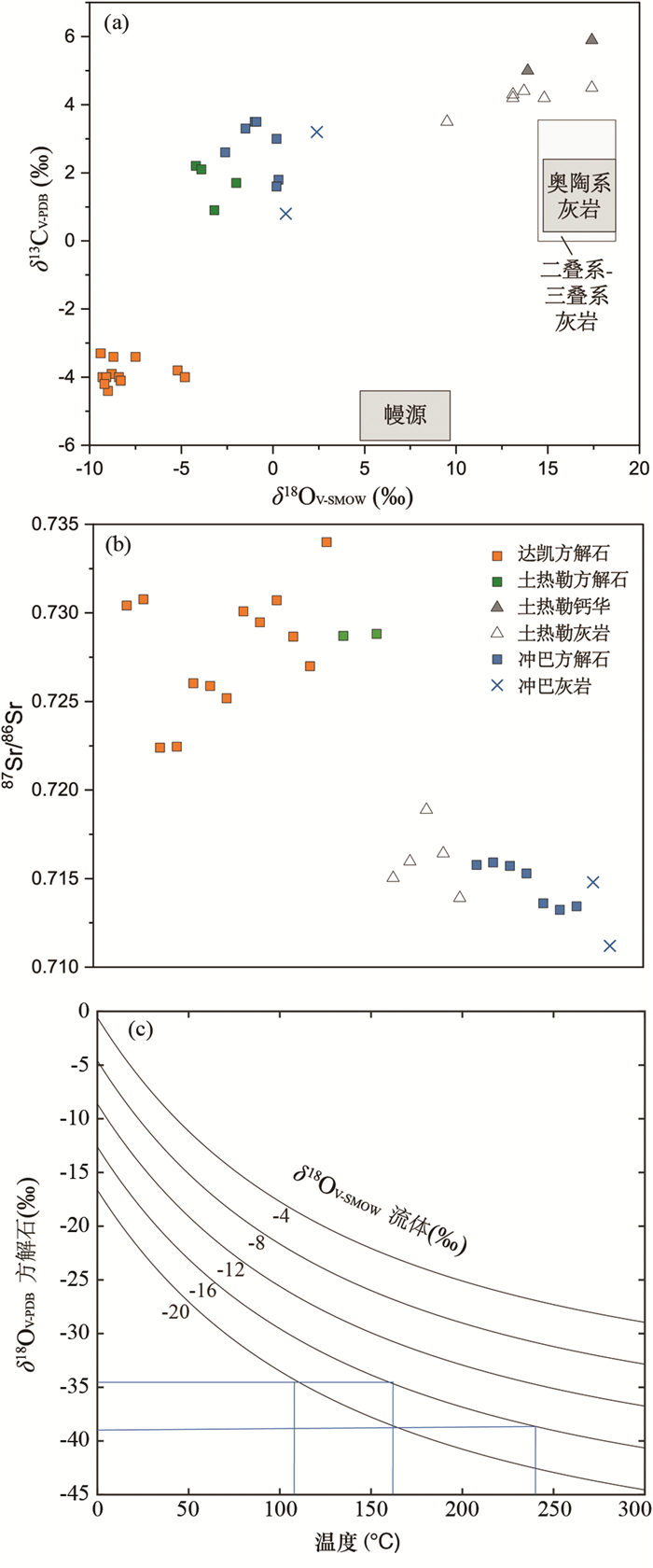
|
图 8 方解石脉、围岩和钙华的同位素特征 (a)本文样品、区域碳酸盐岩及幔源流体的δ13CV-PDB (‰)-δ18OV-SMOW (‰)分布,其中区域奥陶系灰岩数值据Yu et al. (2021),二叠-三叠系灰岩据Shen et al. (2010);(b)各研究点样品87Sr/86Sr同位素比值;(c)在流体和方解石处于平衡状态的条件下,方解石-流体的氧同位素特征与温度的关系,1000lnα=2.78(106T-2)-3.39 (适用于0~500℃),其中α为分馏因子,T为开尔文温度,据O’Neil et al. (1969) Fig. 8 Isotopic characteristics of calcite veins, host rocks and travertine (a) the δ13C V-PDB (‰) vs. δ18OV-SMOW (‰) distribution of the samples from this paper, regional limestone and mantle-derived fluid. Ordovician limestone data after Yu et al. (2021); Permian-Triassic limestone data from Shen et al. (2010). (b) 87Sr/86Sr isotope ratio. (c) oxygen isotope characteristics of calcite-fluid and its relation to temperature under the condition of fluid and calcite in equilibrium, 1000 lnα=2.78(106T-2)-3.39, where α is the fractionation factor and T is the Kelvin temperature, based on O'Neil et al. (1969) |
涅如堆地堑达凯研究点方解石脉δ13CV-PDB值为-9.4‰~-4.8‰、平均值为-8.2±0.3‰,δ18OV-SMOW值为-4.4‰~-3.3‰、平均值为-3.9±1.5‰。涅如堆地堑达土热勒研究点方解石脉δ13CV-PDB值为+0.9‰~+2.2‰、平均值为+1.7±0.5‰,δ18OV-SMOW值为-4.2‰~-2‰、平均值为-3.3±0.8‰;围岩δ13CV-PDB值为+3.5‰~+4.5‰、平均值为+4.2±0.3‰,δ18OV-SMOW值为+9.5‰~+17.4‰、平均值为+13.6±2.4‰;钙华δ13CV-PDB值为+5‰~+5.9‰、平均值为+5.5±0.5‰,δ18OV-SMOW值为+13.9‰~+17.4‰、平均值为+15.6±1.8‰。帕里地堑冲巴研究点方解石脉δ13CV-PDB值为+1.6‰~+3.5‰、平均值为+2.8±0.7‰,δ18OV-SMOW值为-2.6‰~+0.3‰、平均值为-0.8±1.0‰;围岩δ13CV-PDB值为+0.8‰~+3.2‰、平均值为+2±1.2‰,δ18OV-SMOW值为+0.7‰~+2.4‰、平均值为+1.6±0.9‰。
藏南地区报道的奥陶系碳酸盐岩δ13CV-PDB为0.17‰~2.32‰、δ18OV-PDB为-15.33‰~-11.45‰(Yu et al., 2021),二叠-三叠系碳酸盐岩δ13 CV-PDB为0至4‰、δ18OV-PDB为-14‰至-12‰(Shen et al., 2010)。达凯研究点方解石脉与区域内碳酸盐岩相比具有较低的δ13CV-PDB值,其他两处采样点方解石脉δ13CV-PDB值与区域值相符(图 8a)。
各研究点方解石脉的δ18OV-PDB值均轻于围岩以及藏南地区碳酸盐岩,值得注意的是,达凯研究点方解石脉具有极低的δ18OV-PDB值。方解石脉中的δ18OV-PDB特征取决于沉淀流体的来源和沉淀温度(Faure, 1998)。假设大气水在全新世没有显着变化,并且代表了过去的地下水,参考海拔3000m以上的高喜马拉雅河流已发布的δ18OV-SMOW值(-16‰~-19‰)(Gajurel al., 2006;Li and Garzione, 2017),使用碳酸盐-流体古温度计(O’Neil et al., 1969),可以计算出,如果达凯研究点方解石脉来源为大气水,则沉淀温度在122~252℃之间(图 8c),若来源为大气水以及相邻区域碳酸盐岩,则需要更高的沉淀温度。
4.2 87Sr/86Sr同位素和REY元素模式涅如堆地堑达凯和土热勒研究点方解石脉87Sr/86Sr同位素比值介于0.7224~0.7340之间(图 8b, 表 1)。明显高于土热勒灰岩围岩的87Sr/86Sr同位素比值(0.7139~0.7189)。帕里地堑冲巴研究点方解石脉87 Sr/86 Sr同位素比值介于0.7132~0.7159之间。与奥陶系灰岩围岩87Sr/86Sr同位素(0.7112~0.7148)一致。
方解石脉和围岩样品的稀土元素(包括钇)含量见表 2。球粒陨石标准化的REY图中显示,达凯研究点方解石脉表现为富LREE和Eu正异常,土热勒研究点方解石脉表现为富LREE,Eu负异常以及Y正异常,冲巴研究点表现为富LREE,Eu负异常(图 9)。
|
|
表 2 亚东裂谷方解石脉和围岩REY元素分析结果(×10-6) Table 2 REY compositions of the calcite veins and host rock in Yadong rift (×10-6) |
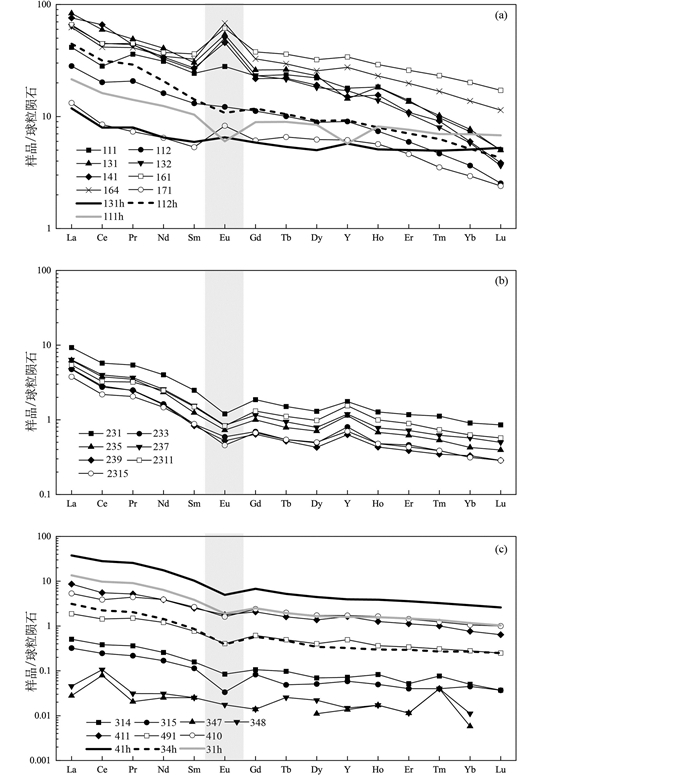
|
图 9 达凯研究点(a)、土热勒研究点(b)和冲巴研究点(c)方解脉和围岩的球粒陨石标准化REY模式(标准化值据Haskin et al., 1968) Fig. 9 Chondrite-normalized REY-patterns of calcite veins and host rock from Dakai (a), Turele (b), and Chumba (c) sites (normalized values after Haskin et al., 1968) |
我们对达凯研究点3个擦痕方解石脉,土热勒研究点2个断层方解石脉,和冲巴研究点3个断层方解石脉进行U-Th年代学测定(表 3)。
|
|
表 3 亚东裂谷断层方解石脉U系测年结果 Table 3 U-series dating of calcite veins in the Yadong rift |
达凯研究点发育擦痕的方解石脉(YD112、YD132和YD164样品)均具有块状晶体结构,测得其年龄超过测试上限(大于600ka)。土热勒研究点F3方解石脉(NFA0样品)具有块状结构,测得年龄为679±129ka,F4方解石脉230Th/232Th值过低(4×10-6~5×10-6),测得年龄超过测试上限(大于600ka)。冲巴研究点F6断层方解石脉YD410样品表面发与擦痕,且具有块状内部结构,测得年龄为544±26ka,F7断层方解石脉具有拉长的块状结构,在YD314和YD348样品中(图 6i, j)测得年龄为408±13ka和444±15ka。微观结构观察显示这些方解石脉未重结晶,表明以上年龄是可靠的。
6 讨论 6.1 方解石脉结构与成因断层作用各时期形成的方解石脉类型包括:(1)水力压裂产生的同震结晶:晶体形态为块状,非自形等粒结构,形成于流体压力快速下降或流体突然停止上升导致的高矿物饱和度(图 10a)(Phillips, 1972;Bons,2001;Boullier et al., 2004;Uysal et al., 2007)。(2)断层拉张部位的同构造结晶:晶体形态为拉长块状和扩展状(Bons et al., 2012)。拉长块状脉晶体具有明显的竞争生长特征,平均晶粒宽度沿生长方向增加,通常沿围岩表面向裂缝内生长(图 10b)(Durney and Ramsay, 1973;Oliver and Bons, 2001)。扩展状脉具有横跨整个脉宽的晶体,是通过对在先存晶粒的不同位置多次破裂和愈合而形成的(Durney and Ramsay, 1973;Ramsay, 1980)。(3)震间期沉淀,如纤维脉(图 10c)(Hilgers et al., 2001;Nollet et al., 2005)和暴露面的薄层泥晶涂层(Flotté et al., 2001;Nuriel et al., 2012)。
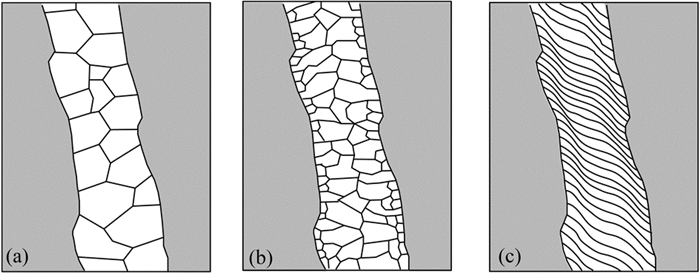
|
图 10 方解石脉内部特征结构(据Woodcock et al., 2007) (a)块状脉,等粒结构;(b)拉长块状脉,具有竞争生长特征,一般沿围岩表面向裂缝内生长;(c)纤维脉,晶体延伸方向指示裂隙开启轨迹 Fig. 10 Typical microstructures of calcite vein (after Woodcock et al., 2007) (a) blocky vein, granular equant texture; (b) elongate blocky vein, with competitive growth characteristics, generally from the host wall to the fracture; (c) fibrous vein, crystal extension direction indicates crack opening trajectory |
本次研究中亚东裂谷涅如堆段发育的方解石胶结物和擦痕脉的微观结构具有等粒块状结构(图 7c, d),且具有不平直的脉体边界,代表了与地震断层滑动相关的拉张部位的方解石快速沉淀(Gratier and Gamond, 1990;Nuriel et al., 2019)。亚东裂谷帕里段一处沿断层发育的方解石脉具有拉长的块状结构(图 7e, f)代表同构造时期的裂缝愈合。没有观察到与溶解沉淀相关的裂缝缓慢愈合的证据,如纤维脉和泥质涂层(Gratier and Gamond, 1990;Hilgers et al., 2001;Nuriel et al., 2012; Zhang et al., 2015)。CL观察表明,方解石擦痕样品CL颜色均匀(图 7d),表明在单个沉淀事件期间结晶。由于每个破裂-愈合事件都意味着裂缝打开,块状或拉长块状晶体从充满流体的开放裂缝中析出(Hilgers et al., 2001),多条平行发育的方解石脉代表多次裂缝密封事件(图 7g, h、图 11)。本文中样品观测显示,不同期次的层状脉被围岩包体条带(图 7e, f)分隔,或被锋利的晶体间破裂切割(图 7c, d),表明新的破裂事件均在早期裂缝完全密封后才发生。
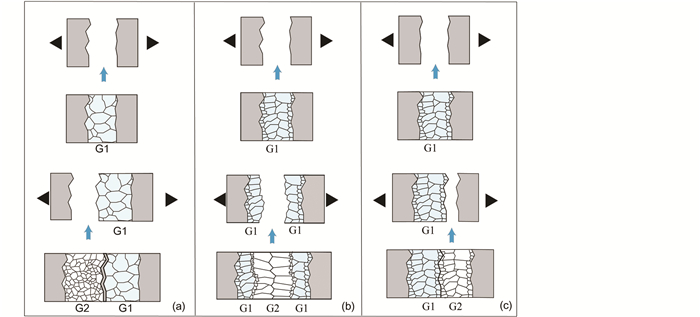
|
图 11 亚东裂谷地震相关方解石脉生长模式 (a)块状方解石脉的形成过程,由于晶体沉淀时温度压力以及矿物过饱和程度等条件不同,将形成不同粒径的方解石晶体,G1和G2分别代表第一、二期方解石沉淀;(b、c)两期拉长块状脉,第二次破裂位置分别位于脉体中间和脉-围岩边界 Fig. 11 Growth patterns of earthquake-related calcite veins in the Yadong rift (a) formation process of blocky calcite veins, calcite crystals with different particle sizes due to different conditions such as temperature, pressure and mineral supersaturation during crystal precipitation. G1 and G2 represent the first and second stages of calcite precipitation respectively. (b, c) two stages of elongated blocky veins, second fracture position located in the center of the vein, and boundary between vein and host rock, respectively |
根据图 8a, δ13CV-PDB和δ18OV-SMOW两者具有比较明显的线性关系,指示流体具有二元混合特征。本文的三个研究点中,达凯点具有异常轻的碳氧同位素特征。碳同位素组成表明,方解石中的碳可能来自地球深处(即地幔或下地壳),也可能来自碳酸盐或有机质。然而,δ13C值较集中,排除了有机来源的可能性,位于幔源碳(-5.5±0.5‰)(Sakai and Matsuhisa, 1996)和区域内碳酸盐岩之间,表明具有幔源贡献。极低的δ18O值反映了大气水来源,以及高于120℃的沉淀温度。方解石脉的高Sr同位素比值超过区域内奥陶系,二叠-三叠系灰岩的同位素值。因此排除了方解石仅来自溶解了碳酸钙的大气水。高Sr同位素比值表明,在流体的运移过程中通过了放射成因的基岩,如高Sr比值的硅质碎屑和花岗岩(McNutt, 2000)。因此区域内喜马拉雅淡色花岗岩体(Sr比值0.756~0.775)(杨晓松和金振民,2001;李开玉等,2020)以及二叠系板岩围岩为流体提供了高Sr比值特征。深层渗透的大气水与变质/花岗质基岩的相互作用很可能发生在温度高于122~252℃的条件下,Eu正异常同样指示了热液环境。因此该点的方解石脉形成机制可能为幔源脱气与深层大气水混合成因(图 12)。外部来源的流体反映了脉体形成于开放系统,即断层活动时的裂隙连通状态,这与块状结构方解石脉代表的同震时期相匹配。
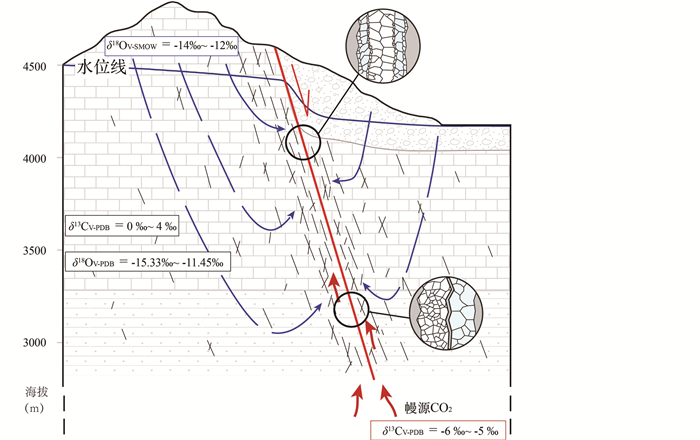
|
图 12 地震相关的断裂带流体循环模式图 蓝色箭头为向下渗入岩层和断层的大气水,红色箭头代表与地震有关的深层流体沿断裂带上升,环境温度与埋深正相关.浅部形成的方解石脉主要包含灰岩围岩和大气水特征,深部形成的方解石脉显示深部流体和大气水共同作用 Fig. 12 Earthquake-related fluid circulation pattern within the fault zone Blue arrows indicate meteoric water infiltrating downward into rock stratum and fault, red arrows indicate that the deep fluids related to earthquake rise along the fault zone, with temperature being positively correlated with buried depth. Shallow calcite veins are mainly contained within limestone and meteorite water, while deep calcite veins show the interaction of deep fluids and meteorite water |
土热勒和冲巴研究点方解石脉具有相似的地球化学特征,δ13CV-PDB值与区域碳酸盐岩一致(Shen et al., 2010;Yu et al., 2021),δ18OV-SMOW值低于碳酸盐围岩,表明具有大气水贡献。Ce和Eu负异常以及Y的正异常反映了低温氧化环境(Bau et al., 1997;Bolhar et al., 2004)。考虑到三个研究点所处位置邻近,脉体记录的温度特征能够对应相对埋深,与达凯研究点方解石具有的高温条件相比,土热勒和冲巴研究点方解石形成于更浅的区域。分析的样品还显示了与灰岩围岩密切相关的方解石REY特征和87Sr/86Sr值,指示了流体来自大气水以及溶解的碳酸盐岩(图 12)。
6.3 方解石脉与地震活动地震引起岩石破裂后,流体发生突然的压力降低和平衡浓度改变(Putnis et al., 1995;Robert et al., 1995;Barnes and Rose, 1998;Putnis and Mauthe, 2001),因此形成充填于裂缝或角砾间的矿物沉淀。受到矿物过饱和程度,裂隙张开宽度,以及先存晶体取向的不同,沉淀的矿物晶体具有块状或拉长块状等结构(Oliver and Bons, 2001;Nollet et al., 2005;Woodcock et al., 2007)。活动断层的实验和观察表明,在愈合作用影响下,同震期间形成的张裂隙将在此后很快(几天到几个月)关闭(Hiramatsu et al., 2005; Li et al., 2006)。本次研究中沿断层阶步部位发育的方解石脉均具有块状结构,代表同震时期方解石沉淀,部分样品发育由平直破裂面分隔的多层脉体,代表了流体多次注入。土热勒研究点沿断层面发育的方解石脉体内部发育棱角状围岩角砾,代表断层滑动期间岩石破裂伴随的流体注入。冲巴研究点沿断层面发育一套厚层方解石脉,具有拉长的块状结构,代表震后同构造期的破裂愈合。因此本文中选取的方解石脉能够代表同震或同构造的断层活动。即研究区自北向南,达凯断层记录了超过两期的地震活动,活动时间距今均超过600ka;土热勒研究点F3断层在距今679±129ka发生一期地震活动;冲巴研究点记录了NNE向断层544±26ka的地震活动以及,NE向F7断层408±13ka和444±15ka的两期地震活动。在以上三个研究点中,涅如堆地堑南段土热勒点发育的断层三角面较为完整,新鲜断层面与三角面顶部高差约150m,断层倾角为57°。若本研究中方解石脉记录的地震年龄为初始活动时间,则裂谷该段中更新世以来的E-W向伸展速率为0.17~0.24mm/yr,由于方解石脉的沉淀晚于最早期的断层活动,因此断层实际活动时期更长,因此该速率为最大值,即中更新世以来的伸展速率小于晚更新世以来0.8±0.3mm/yr的伸展速率(Wang et al., 2020), 以及GPS观测的现今伸展速率6mm/yr(哈广浩,2019)。即中更新世以来,亚东裂谷涅如堆段断层活动速率增大。
7 结论本文通过对藏南亚东裂谷地区断裂带中的方解石脉体成因、地球化学以及年代学分析,得到以下认识:
(1) 亚东裂谷涅如堆段和帕里段沿裂谷断层发育方解石脉。三个采样点中沿断层面阶步产出的方解石脉具有块状结构,土热勒点沿断层面发育的方解石脉体中包含角砾状围岩,以上两种结构代表了流体在同震阶段的快速沉淀;冲巴点沿断层发育一处厚层方解石脉,具有拉长的块状结构,代表震后同构造阶段的流体沉淀。
(2) 涅如堆地堑北部方解石脉REY模式反映了热液特征,异常轻的δ13CV-PDB值具有幔源特征,而极低的δ18OV-SMOW值显示出大气水贡献。涅如堆地堑南部和帕里地堑北部方解石脉REY模式反映了浅成的低温特征,δ13CV-PDB和87 Sr/86Sr值与区域内灰岩相近,代表了围岩对方解脉的贡献,偏负的δ18OV-SMOW表明方解石脉同样存在大气水贡献。
(3) 地球化学数据显示,达凯点方解石脉显示了来自大气水和地幔流体贡献,沉淀温度约为122~252℃,土热勒和冲巴点的流体来源主要为灰岩围岩和大气水,方解石在低温条件沉淀。地震相关的挤压和破裂导致地幔流体延断层上升,在深部区域与下渗或深埋的大气水共同导致方解石沉淀。在浅部区域,由于地震破裂产生的压力和温度变化,灰岩中过饱和流体和浅部地下水混合产生方解石沉淀。
(4) 方解石脉的显微结构和地球化学数据显示,脉体形成与地震活动相关,其中裂谷的涅如堆段记录了一期679±129ka的地震活动,且该段断层活动速率从中更新世明显增大;帕里段北部记录了544±26ka、444±15ka和408±13ka三期地震活动。
致谢 铀系测年工作得到西安交通大学同位素实验室宁有丰研究员和贾雪雪的悉心指导,碳氧同位素数据分析得到了中国地质科学院矿产资源研究所高建飞副研究员的宝贵建议和指导。刘俊来教授、张波副教授和本刊编辑提出了宝贵意见和建议。在此一并表示感谢。
Armijo R, Tapponnier P, Mercier JL and Han TL. 1986. Quaternary extension in southern Tibet: Field observations and tectonic implications. Journal of Geophysical Research: Solid Earth, 91(B14): 13803-13872 DOI:10.1029/JB091iB14p13803
|
Baltz T. 2012. Structural evolution of Thakkhola Graben: Implications for the architecture of the Central Himalaya, Nepal. Master Degree Thesis. Houston: University of Houston, 1-98
|
Barberio MD, Barbieri M, Billi A, Doglioni C and Petitta M. 2017. Hydrogeochemical changes before and during the 2016 Amatrice-Norcia seismic sequence (central Italy). Scientific Reports, 7(1): 11735 DOI:10.1038/s41598-017-11990-8
|
Barnes HL and Rose AW. 1998. Origins of hydrothermal ores. Science, 279(5359): 2064-2065 DOI:10.1126/science.279.5359.2064
|
Bau M, Möller P and Dulski P. 1997. Yttrium and lanthanides in eastern Mediterranean seawater and their fractionation during redox-cycling. Marine Chemistry, 56(1-2): 123-131 DOI:10.1016/S0304-4203(96)00091-6
|
Bergman SC, Huntington KW and Crider JG. 2013. Tracing paleofluid sources using clumped isotope thermometry of diagenetic cements along the Moab Fault, Utah. American Journal of Science, 313(5): 490-515 DOI:10.2475/05.2013.03
|
Bolhar R, Kamber BS, Moorbath S, Fedo CM and Whitehouse MJ. 2004. Characterisation of Early Archaean chemical sediments by trace element signatures. Earth and Planetary Science Letters, 222(1): 43-60 DOI:10.1016/j.epsl.2004.02.016
|
Bons PD. 2001. The formation of large quartz veins by rapid ascent of fluids in mobile hydrofractures. Tectonophysics, 336(1-4): 1-17 DOI:10.1016/S0040-1951(01)00090-7
|
Bons PD, Elburg MA and Gomez-Rivas E. 2012. A review of the formation of tectonic veins and their microstructures. Journal of Structural Geology, 43: 33-62 DOI:10.1016/j.jsg.2012.07.005
|
Boullier AM, Fujimoto K, Ohtani T, Roman-Ross G, Lewin é, Ito H, Pezard P and Ildefonse B. 2004. Textural evidence for recent co-seismic circulation of fluids in the Nojima fault zone, Awaji Island, Japan. Tectonophysics, 378(3-4): 165-181 DOI:10.1016/j.tecto.2003.09.006
|
Brogi A, Capezzuoli E, Alçiçek MC and Gandin A. 2014. Evolution of a fault-controlled fissure-ridge type travertine deposit in the western Anatolia extensional province: The Çukurbaǧ fissure-ridge (Pamukkale, Turkey). Journal of the Geological Society, 171(3): 425-441 DOI:10.1144/jgs2013-034
|
Cheng H, Edwards RL, Hoff J, Gallup CD, Richards DA and Asmerom Y. 2000. The half-lives of uranium-234 and thorium-230. Chemical Geology, 169(1-2): 17-33 DOI:10.1016/S0009-2541(99)00157-6
|
Cheng H, Edwards RL, Shen CC, Polyak VJ, Asmerom Y, Woodhead J, Hellstrom J, Wang YJ, Kong XG, Spötl C, Wang XF and Alexander EC Jr. 2013. Improvements in 230Th dating, 230Th and 234U half-life values, and U-Th isotopic measurements by multi-collector inductively coupled plasma mass spectrometry. Earth and Planetary Science Letters, 371-372: 82-91 DOI:10.1016/j.epsl.2013.04.006
|
Chevalier ML, Tapponnier P, Van Der Woerd J, Leloup PH, Wang S, Pan J, Bai M, Kali E, Liu X and Li H. 2020. Late Quaternary extension rates across the northern half of the Yadong-Gulu Rift: Implication for east-west extension in southern Tibet. Journal of Geophysical Research: Solid Earth, 125(7): e2019JB019106
|
Coplen TB, Kendall C and Hopple J. 1983. Comparison of stable isotope reference samples. Nature, 302(5905): 236-238 DOI:10.1038/302236a0
|
De Filippis L, Faccenna C, Billi A, Anzalone E, Brilli M, Soligo M and Tuccimei P. 2013. Plateau versus fissure ridge travertines from Quaternary geothermal springs of Italy and Turkey: Interactions and feedbacks between fluid discharge, paleoclimate, and tectonics. Earth-Science Reviews, 123: 35-52 DOI:10.1016/j.earscirev.2013.04.004
|
Dolejš D and Manning CE. 2010. Thermodynamic model for mineral solubility in aqueous fluids: Theory, calibration and application to model fluid-flow systems. Geofluids, 10(1-2): 20-40
|
Durney DW and Ramsay JG. 1973. Incremental strains measured by syntectonic crystal growths. In: De Jong KA and Schölten R (eds.). Gravity and Tectonics. New York: John Wiley & Sons, 67-96
|
Edwards RL, Chen JH and Wasserburg GJ. 1987. 238U-234U-230Th-232Th systematics and the precise measurement of time over the past 500, 000 years. Earth and Planetary Science Letters, 81(2-3): 175-192 DOI:10.1016/0012-821X(87)90154-3
|
Eyal Y, Kaufman A and Bar-Matthews M. 1992. Use of 230Th/U ages of striated carnotites for dating fault displacements. Geology, 20(9): 829-832 DOI:10.1130/0091-7613(1992)020<0829:UOTUAO>2.3.CO;2
|
Faure G. 1998. Principles and Applications of Geochemistry. 2nd Edition. Upper Saddle River, NJ: Prentice-Hall, 1-600
|
Flotté N, Plagnes V, Sorel D and Benedicto A. 2001. Attempt to date Pleistocene normal faults of the Corinth-Patras Rift (Greece) by U/Th Method, and tectonic implications. Geophysical Research Letters, 28(19): 3769-3772 DOI:10.1029/2001GL012964
|
Gajurel AP, France-Lanord C, Huyghe P, Guilmette C and Gurung D. 2006. C and O isotope compositions of modern fresh-water mollusc shells and river waters from the Himalaya and Ganga plain. Chemical Geology, 233(1-2): 156-183 DOI:10.1016/j.chemgeo.2006.03.002
|
Gratier JP and Gamond JF. 1990. Transition between seismic and aseismic deformation in the upper crust. Geological Society, London, Special Publications, 54(1): 461-473 DOI:10.1144/GSL.SP.1990.054.01.42
|
Ha GH. 2019. Normal faulting of central-southern Yadong-Gulu rift since Late Cenozoic, Southern Tibet. Ph. D. Dissertation. Beijing: Chinese Academy of Geological Sciences, 1-147 (in Chinese with English summary)
|
Ha GH, Wu ZH, Gai HL and Zuo JM. 2019a. New discovery of surface rupture of large paleo-earthquake along northern Pagri-Duoqing Co Graben, Southern Yadong-Gulu Rift. Acta Geologica Sinica, 93(4): 1135-1136 DOI:10.1111/1755-6724.13829
|
Ha GH, Wu ZH and Liu F. 2019b. Late Quaternary vertical slip rates along the southern Yadong-Gulu Rift, Southern Tibetan Plateau. Tectonophysics, 755: 75-90 DOI:10.1016/j.tecto.2019.02.014
|
Haskin LA, Haskin MA, Frey FA and Wildeman TR. 1968. Relative and absolute terrestrial abundances of the rare earths. Origin and Distribution of the Elements: Pergamon Press, 889-912
|
Hilgers C, Koehn D, Bons PD and Urai JL. 2001. Development of crystal morphology during unitaxial growth in a progressively widening vein: Ⅱ. Numerical simulations of the evolution of antitaxial fibrous veins. Journal of Structural Geology, 23(6-7): 873-885 DOI:10.1016/S0191-8141(00)00160-7
|
Hiramatsu Y, Honma H, Saiga A, Furumoto M and Ooida T. 2005. Seismological evidence on characteristic time of crack healing in the shallow crust. Geophysical Research Letters, 32(9): L09304
|
Kapp P and Guynn JH. 2004. Indian punch rifts Tibet. Geology, 32(11): 993-996 DOI:10.1130/G20689.1
|
Kapp P, Taylor M, Stockli D and Ding L. 2008. Development of active low-angle normal fault systems during orogenic collapse: Insight from Tibet. Geology, 36(1): 7-10 DOI:10.1130/G24054A.1
|
Leloup PH, Mahéo G, Arnaud N, Kali E, Boutonnet E, Liu DY, Liu XH and Li HB. 2010. The South Tibet detachment shear zone in the Dinggye area: Time constraints on extrusion models of the Himalayas. Earth and Planetary Science Letters, 292(1-2): 1-16 DOI:10.1016/j.epsl.2009.12.035
|
Li CF, Chu ZY, Wang XC, Guo JH and Wilde SA. 2019. Sr isotope analysis of picogram-level samples by thermal ionization mass spectrometry using a highly sensitive silicotungstic acid emitter. Analytical Chemistry, 91(11): 7288-7294 DOI:10.1021/acs.analchem.9b00958
|
Li KY, Chevalier ML, Li HB, Pan JW, Wang SG, Bai MK, Liu FC and Wang P. 2020. Thermochronology of the Chumba Yumco leucogranite, southern Tibet: Constraints on the onset time of the STDS and the Yadong rift. Acta Petrologica Sinica, 36(10): 3097-3116 (in Chinese with English abstract) DOI:10.18654/1000-0569/2020.10.10
|
Li L and Garzione CN. 2017. Spatial distribution and controlling factors of stable isotopes in meteoric waters on the Tibetan Plateau: Implications for paleoelevation reconstruction. Earth and Planetary Science Letters, 460: 302-314 DOI:10.1016/j.epsl.2016.11.046
|
Li YG, Chen P, Cochran ES, Vidale JE and Burdette T. 2006. Seismic evidence for rock damage and healing on the San Andreas fault associated with the 2004 M6.0 Parkfield earthquake. Bulletin of the Seismological Society of America, 96(4B): S349-S363 DOI:10.1785/0120050803
|
Liu JH, Yi CL, Li YK, Bi WL, Zhang Q and Hu G. 2017. Glacial fluctuations around the Karola Pass, eastern Lhagoi Kangri Range, since the Last Glacial Maximum. Journal of Quaternary Science, 32(4): 516-527 DOI:10.1002/jqs.2946
|
Liu WC, Zhou ZG, Gao DZ, Wan XQ and Zhao XG. 2006. Late Pleistocene-Holocene lacustrine deposits and paleolake evolution in the Pagri area, Yadong County, southern Tibet, China. Geological Bulletin of China, 25(6): 708-714 (in Chinese with English abstract)
|
Liu WC, Zhou ZG and Li GB, et al. 2014. Regional Geological Survey of the People's Republic of China Report Gyangze County Sheet (H45C004004), Yadong County Sheet (G45C001004) Scale 1:250000. Beijing: China University of Geosciences Press (in Chinese)
|
McNutt RH. 2000. Strontium isotopes. In: Cook PG and Herczeg AL (eds.). Environmental Tracers in Subsurface Hydrology. Boston, MA: Springer, 233-260
|
Menzies CD, Teagle DAH, Craw D, Cox SC, Boyce AJ, Barrie CD and Roberts S. 2014. Incursion of meteoric waters into the ductile regime in an active orogen. Earth and Planetary Science Letters, 399: 1-13 DOI:10.1016/j.epsl.2014.04.046
|
Molnar P and Tapponnier P. 1978. Active tectonics of Tibet. Journal of Geophysical Research: Solid Earth, 83(B11): 5361-5375 DOI:10.1029/JB083iB11p05361
|
Nollet S, Hilgers C and Urai J. 2005. Sealing of fluid pathways in overpressure cells: A case study from the Buntsandstein in the Lower Saxony Basin (NW Germany). International Journal of Earth Sciences, 94(5): 1039-1055
|
Nuriel P, Rosenbaum G, Uysal TI, Zhao J, Golding SD, Weinberger R, Karabacak V and Avni Y. 2011. Formation of fault-related calcite precipitates and their implications for dating fault activity in the East Anatolian and Dead Sea fault zones. Geological Society, London, Special Publications, 359(1): 229-248 DOI:10.1144/SP359.13
|
Nuriel P, Rosenbaum G, Zhao JX, Feng YX, Golding SD, Villemant B and Weinberger R. 2012. U-Th dating of striated fault planes. Geology, 40(7): 647-650 DOI:10.1130/G32970.1
|
Nuriel P, Craddock J, Kylander-Clark ARC, Uysal IT, Karabacak V, Dirik RK, Hacker BR and Weinberger R. 2019. Reactivation history of the North Anatolian fault zone based on calcite age-strain analyses. Geology, 47(5): 465-469 DOI:10.1130/G45727.1
|
Oliver NHS and Bons PD. 2001. Mechanisms of fluid flow and fluid-rock interaction in fossil metamorphic hydrothermal systems inferred from vein-wallrock patterns, geometry and microstructure. Geofluids, 1(2): 137-162 DOI:10.1046/j.1468-8123.2001.00013.x
|
O'Neil JR, Clayton RN and Mayeda TK. 1969. Oxygen isotope fractionation in divalent metal carbonates. The Journal of Chemical Physics, 51(12): 5547-5558 DOI:10.1063/1.1671982
|
Peng X, Chen YX, Liu BB, Liu GN, Liu Q and Liu JN. 2018. Timing and features of a late MIS 2 rock avalanche in the Eastern Himalayas, constrained by 10Be exposure dating. Geomorphology, 318: 58-68 DOI:10.1016/j.geomorph.2018.05.022
|
Phillips WJ. 1972. Hydraulic fracturing and mineralization. Journal of the Geological Society, 128(4): 337-359 DOI:10.1144/gsjgs.128.4.0337
|
Putnis A, Prieto M and Fernandez-Diaz L. 1995. Fluid supersaturation and crystallization in porous media. Geological magazine, 132(1): 1-13 DOI:10.1017/S0016756800011389
|
Putnis A and Mauthe G. 2001. The effect of pore size on cementation in porous rocks. Geofluids, 1(1): 37-41 DOI:10.1046/j.1468-8123.2001.11001.x
|
Ramsay JG. 1980. The crack-seal mechanism of rock deformation. Nature, 284(5752): 135-139 DOI:10.1038/284135a0
|
Robert F, Boullier AM and Firdaous K. 1995. Gold-quartz veins in metamorphic terranes and their bearing on the role of fluids in faulting. Journal of Geophysical Research: Solid Earth, 100(B7): 12861-12879 DOI:10.1029/95JB00190
|
Sakai H and Matsuhisa Y. 1996. Stable Isotope Geochemistry. Tokyo: University of Tokyo Press
|
Shen SZ, Cao CQ, Zhang YC, Li WZ, Shi GR, Wang Y, Wu YS, Ueno K, Henderson CM, Wang XD, Zhang H, Wang XJ and Chen J. 2010. End-Permian mass extinction and palaeoenvironmental changes in Neotethys: Evidence from an oceanic carbonate section in southwestern Tibet. Global and Planetary Change, 73(1-2): 3-14 DOI:10.1016/j.gloplacha.2010.03.007
|
Tapponnier P, Mercier JL, Armijo R, Han TL and Zhou J. 1981. Field evidence for active normal faulting in Tibet. Nature, 294(5840): 410-414 DOI:10.1038/294410a0
|
Tapponnier P, Xu ZQ, Roger F, Meyer B, Arnaud N, Wittlinger G and Yang JS. 2001. Oblique stepwise rise and growth of the Tibet Plateau. Science, 294(5547): 1671-1677 DOI:10.1126/science.105978
|
Uysal IT, Feng YX, Zhao JX, Altunel E, Weatherley D, Karabacak V, Cengiz O, Golding SD, Lawrence MG and Collerson KD. 2007. U-series dating and geochemical tracing of Late Quaternary travertine in co-seismic fissures. Earth and Planetary Science Letters, 257(3-4): 450-462 DOI:10.1016/j.epsl.2007.03.004
|
Uysal IT, Feng YX, Zhao JX, Bolhar R, Işik V, Baublys KA, Yago A and Golding SD. 2011. Seismic cycles recorded in Late Quaternary calcite veins: Geochronological, geochemical and microstructural evidence. Earth and Planetary Science Letters, 303(1-2): 84-96 DOI:10.1016/j.epsl.2010.12.039
|
Verhaert G, Muchez P, Sintubin M, Similox-Tohon D, Vandycke S and Waelkens M. 2003. Reconstruction of neotectonic activity using carbonate precipitates: A case study from the northwestern extremity of the Isparta Angle (SW Turkey). Journal of Geochemical Exploration, 78-79: 197-201 DOI:10.1016/S0375-6742(03)00070-0
|
Verhaert G, Muchez P, Sintubin M, Similox-Tohon D, Vandycke S, Keppens E, Hodge EJ and Richards DA. 2004. Origin of palaeofluids in a normal fault setting in the Aegean region. Geofluids, 4(4): 300-314 DOI:10.1111/j.1468-8123.2004.00094.x
|
Wan XQ, Liang DY and Li GB. 2002. Palaeocene strata in Gamba, Tibet and influence of Tectonism. Acta Geologica Sinica, 76(2): 155-162 (in Chinese with English abstract)
|
Wang SG, Chevalier ML, Pan JW, Bai MK, Li KY, Li HB and Wang GH. 2020. Quantification of the Late Quaternary throw rates along the Yadong rift, southern Tibet. Tectonophysics, 790: 228545 DOI:10.1016/j.tecto.2020.228545
|
Watanabe Y, Nakai SI and Lin AM. 2008. Attempt to determine U-Th ages of calcite veins in the Nojima fault zone, Japan. Geochemical Journal, 42(6): 507-513 DOI:10.2343/geochemj.42.507
|
Williams RT, Goodwin LB, Sharp WD and Mozley PS. 2017. Reading a 400, 000-year record of earthquake frequency for an intraplate fault. Proceedings of the National Academy of Sciences of the United States of America, 114(19): 4893-4898 DOI:10.1073/pnas.1617945114
|
Woodcock NH, Dickson JAD and Tarasewicz JPT. 2007. Transient permeability and reseal hardening in fault zones: Evidence from dilation breccia textures. Geological Society, London, Special Publications, 270(1): 43-53 DOI:10.1144/GSL.SP.2007.270.01.03
|
Wu CD, Nelson KD, Wortman G, Samson SD, Yue YJ, Li JX, Kidd WSF and Edwards MA. 1998. Yadong cross structure and South Tibetan Detachment in the east central Himalaya (89°~90°E). Tectonics, 17(1): 28-45 DOI:10.1029/97TC03386
|
Wu ZH, Ye PS, Barosh PJ and Wu ZH. 2011. The October 6, 2008 Mw 6.3 magnitude Damxung earthquake, Yadong-Gulu rift, Tibet, and implications for present-day crustal deformation within Tibet. Journal of Asian Earth Sciences, 40(4): 943-957 DOI:10.1016/j.jseaes.2010.05.003
|
Yang XS and Jin ZM. 2001. Studies on Rb-Sr and Sm-Nd isotope of Yadong leucogranite in Tibet: Constraint on its age and source material. Geological Review, 47(3): 294-300 (in Chinese with English abstract)
|
Yu SY, Fang X, Zhang YD, Zhen YY, Li WJ, Li Y and Munnecke A. 2021. First record of the Middle Darriwilian δ13C excursion (MDICE) in southern Xizang (Tibet), China, and its implications. Carbonates and Evaporites, 36(2): 33 DOI:10.1007/s13146-021-00703-y
|
Zhang B, Yin CY, Gu ZD, Zhang JJ, Yan SY and Wang Y. 2015. New indicators from bedding-parallel beef veins for the fault valve mechanism. Science China (Earth Sciences), 58(8): 1320-1336 DOI:10.1007/s11430-015-5086-6
|
Zhang HF, Harris N, Parrish R, Zhang L, Zhao ZD and Li DW. 2005. Geochemistry of North Himalayan leucogranites: Regional comparison, petrogenesis and tectonic implications. Earth Science (Journal of China University of Geosciences), 30(3): 275-288 (in Chinese with English abstract)
|
Zhang JJ, Santosh M, Wang XX, Guo L, Yang XY and Zhang B. 2012. Tectonics of the northern Himalaya since the India-Asia collision. Gondwana Research, 21(4): 939-960 DOI:10.1016/j.gr.2011.11.004
|
哈广浩. 2019. 藏南亚东-谷露裂谷中-南段晚新生代正断层作用. 博士学位论文. 北京: 中国地质科学院, 1-147 http://cdmd.cnki.com.cn/article/cdmd-82501-1019146207.htm
|
李开玉, Chevalier ML, 李海兵, 潘家伟, 王世广, 白明坤, 刘富财, 王平. 2020. 藏南冲巴雍错淡色花岗岩体热年代学及其对藏南拆离系和亚东裂谷构造活动时限的制约. 岩石学报, 36(10): 3097-3116. |
刘文灿, 周志广, 高德臻, 万晓樵, 赵兴国. 2006. 藏南亚东县帕里地区晚更新世-全新世湖相地层特征及古湖泊演化. 地质通报, 25(6): 708-714. DOI:10.3969/j.issn.1671-2552.2006.06.009 |
刘文灿, 周志广, 李国彪, 等. 2014. 中华人民共和国区域地质调查报告-江孜县幅(H45C004004)、亚东县幅(G45C001004) 比例尺1:250000. 北京: 中国地质大学出版社.
|
万晓樵, 梁定益, 李国彪. 2002. 西藏岗巴古新世地层及构造作用的影响. 地质学报, 76(2): 155-162. |
杨晓松, 金振民. 2001. 西藏亚东淡色花岗岩Rb-Sr和Sm-Nd同位素研究——关于其年龄和源岩的证据. 地质论评, 47(3): 294-300. DOI:10.3321/j.issn:0371-5736.2001.03.012 |
张宏飞, Harris N, Parrish R, 张利, 赵志丹, 李德威. 2005. 北喜马拉雅淡色花岗岩地球化学: 区域对比、岩石成因及其构造意义. 地球科学(中国地质大学学报), 30(3): 275-288. |
 2021, Vol. 37
2021, Vol. 37


